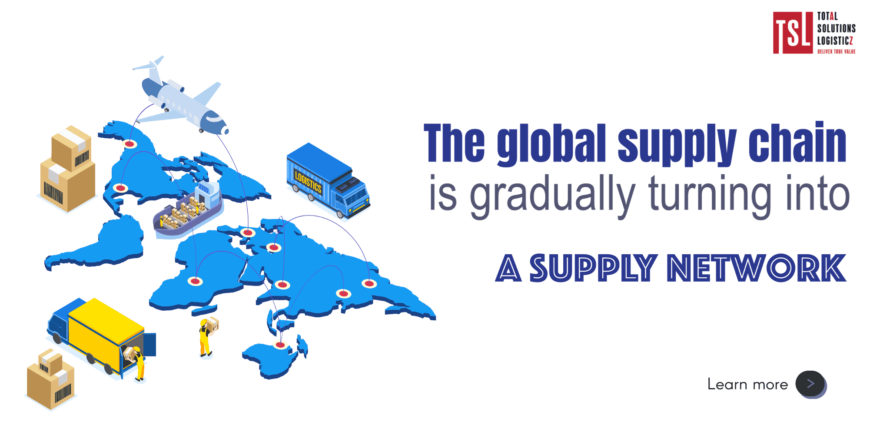The global supply chain is gradually turning into a supply network
A new world order is taking shape for the vital supply chains that supply most of the goods we use every day. Companies, especially technology ones, are questioning the legitimacy of the past 50 years of globalization. Its fundamentals include always looking for the lowest cost manufacturer, no matter the distance, and never carrying excess inventory or parts.
Modern supply chains are designed to save costs. Since the introduction of containers into shipping in the 1960s, supply chains for most goods have grown longer and longer. Cheap and reliable transoceanic and transcontinental shipping means manufacturing can move wherever wages are lowest.
The more complex products, especially the technological ones, in this way minimize the cost, but the disadvantage is that it depends on three characteristics of global trade. The first is that raw materials should always be cheap and widely available. Second, shipping will always cost a small fraction of the value of the goods. Third, the shipping is always reliable. These things were still taken for granted a few years ago.
By 2018, the US-China trade war broke out, causing many manufacturers to see that the above assumptions may no longer hold true. Then, Covid-19 hit. Now, sanctions against Russia, the lingering US-China trade war, combined with natural disasters and difficulties in production and transportation make problems with the globalized supply chain worse. important.
Many companies have worked to make their supply chains stronger, by adding more factories, suppliers and raw materials. The results of change could include shifts in jobs and manufacturing in the coming decades. As companies build more factories, in more locations, and buy parts and materials from more suppliers, the world’s supply chains are becoming more and more like “supply networks”.
In logistics, the shift from supply chains to supply networks is known as “multi-sourcing,” according to Nathan Resnick, President and Co-Founder of Sourcify, a search and management services company. factories in Asia.
Willy Shih is a professor at Harvard University and a member of the Advisory Committee to the US Department of Commerce on how to strengthen domestic supply chains. In a recent essay, he describes how the pandemic has become a wake-up call for regulators. He also pointed to a trend of companies and countries seeking to reposition supply chains within politically allied regional trade blocs.
As companies recognize the risk of supply disruptions, governments are also focusing more on protecting access to goods vital to national security. These policies go by many names. In China, this move towards self-reliance is known as “dual circulation”. It was announced in May 2020. In the European Union, this piece of philosophy related to technology is named “Technology Sovereignty”.
In the US, these efforts include the $52 billion “Chips for America”, approved but unfunded, aimed at bringing the US chip industry, which accounts for 12% of the market share, to recover to around 40% as it was in 1990.
With the demand for microchips on the rise, manufacturers don’t even need to wait for this act. They announced a bunch of new factories, scattered around the world. TSMC, which makes nearly all of the latest-generation chips in Apple products, is spending $100 billion over the next three years to increase its capacity, including new plants in Arizona and Japan.
Intel has committed to spending $95 billion on new production capacity in Europe alone and $20 billion on a new plant in Ohio, which could increase investment to $100 billion. Samsung plans to build a new $17 billion facility in Texas. Even chipmakers using older technology, like Texas Instruments and On Semiconductor, are investing in new and expanding factories.
Encouraging these investments has become a rare point of bipartisan support. Klon Kitchen, Senior National Security and Technology Specialist at the American Enterprise Institute, assesses the situation of geopolitical alliances being torn apart by trade wars and military clashes that are reminiscent of the War Cold War and even World War II.
In the event that tensions escalate between the US and its allies with Russia, China or other allied nations, the US realizes it cannot afford to lose its access to the microchip manufacturing capacity needed to build things. , from weapon systems to smartphones and 5G networks.
Currently, almost all of the world’s advanced IC manufacturing is concentrated in Taiwan. “That makes us extremely nervous when it’s in such a difficult geopolitical position, given the tension between China and Taiwan,” said Emily Kilcrease, Energy Program Manager, Business and Marketing. economics and security at the Center for a New American Security, a Washington think tank.
And computer chips are hardly the only technology where supply chains are being transformed into multi-source supply networks. Battery production, especially for electric vehicles, is currently dominated by China. But dozens of new battery factories are springing up across the US and around the world.
The iPhone, the symbol of the world’s longest and most complex supply chain, continues to stay on schedule thanks in part to the collaboration of Apple and Foxconn. Even before the pandemic, Foxconn took advantage of generous subsidies to redistribute the iPhone assembly network. They split production of this and many other products between Shenzhen and western China. Foxconn has also expanded iPhone production to Chennai, India, and AirPods to Vietnam.
In particular, Southeast Asia has become a hotbed of the region’s “shortage of supply” in terms of technology production. Countries like Vietnam and Thailand are still close to the supply of manufactured goods in China, but labor costs are lower in these two countries.
According to Professor Shih, with most countries in Southeast Asia trying to maintain geopolitical neutrality, the region has the potential to become a supplier to almost every country in the world. For example, Samsung Electronics manufactures the majority of smartphones as well as smart home appliances in Vietnam.
Even if the US wants to try to replicate the entire electronics supply chain at home, from raw materials to finished products, said Lauren Dudley, research analyst focused on competition with China at Rhodium Group. would be extremely difficult, if not impossible.
Some supply chain and supply network researchers say the current shift risks going too far. According to Ms. Kilcrease, if the US tries to achieve the goal of “Technological Sovereignty” like the EU, it will be a mistake. While chips and electronics are important to defense systems, they are still a tiny fraction of the total number of chips produced annually.
No matter what companies and governments invest in, nothing in a system of production and distribution of goods that spans the world changes rapidly. Rearranging decades of globalization, moving both factories and the expertise needed to run them, is a huge investment of money and time.
“To have this separation, as many people have mentioned, is a decades-long project. You really have to have a lot of commitment,” said Professor Shih.









